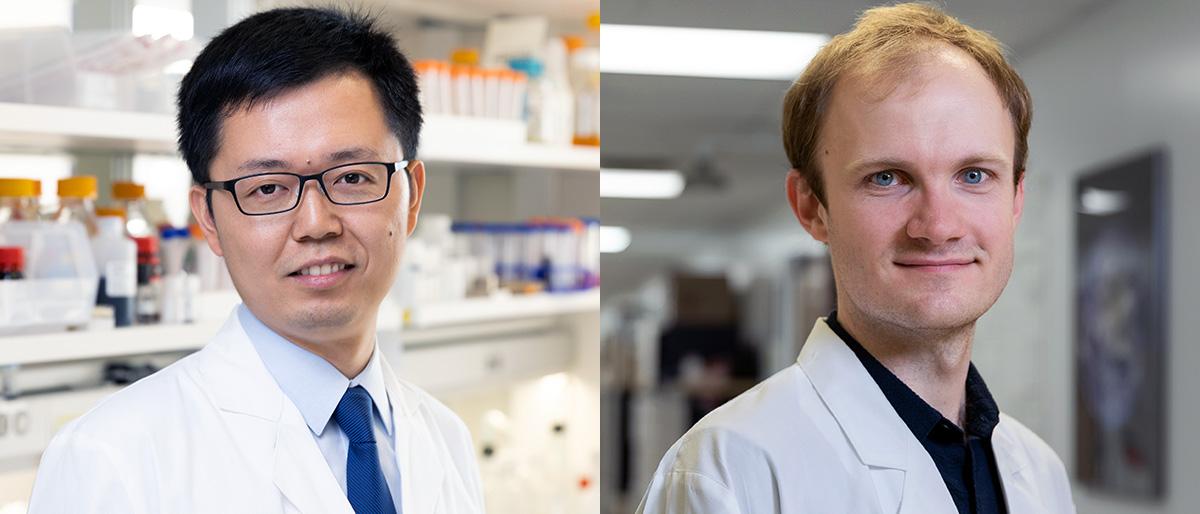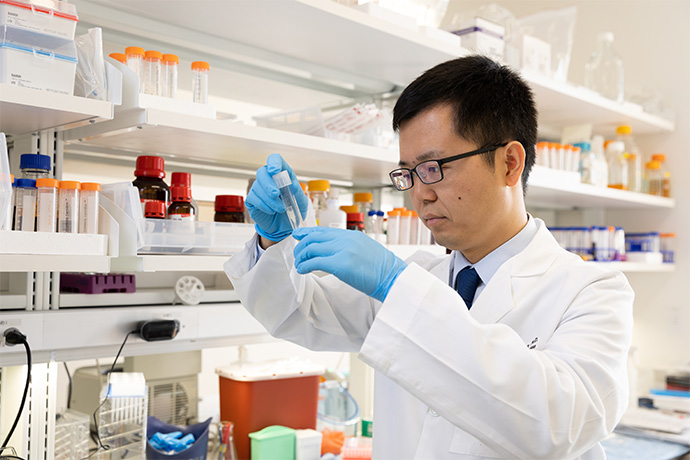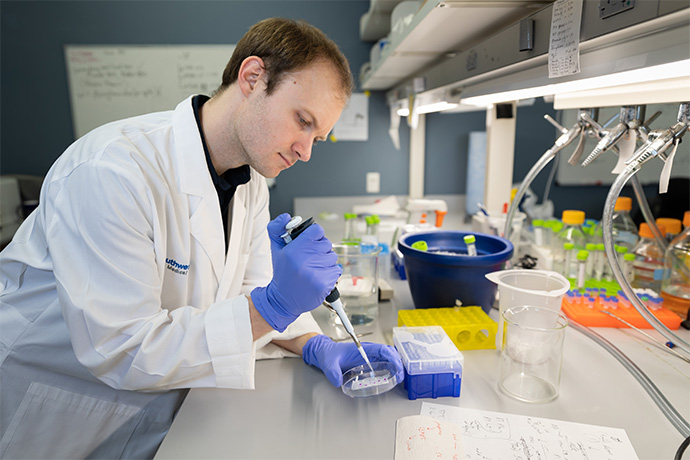What do Neanderthals and Jell-O have in common?
Both inspired UTSW projects awarded 2023 Haberecht Wildhare-Idea Research Grants

Comparing cold tolerance in Neanderthals and modern humans to enhance our understanding of fat metabolism and making experiments with bait molecules faster and cheaper are goals of the newest projects funded by Haberecht Wildhare-Idea Research Grants. The 2023 recipients are Zhao Zhang, Ph.D., and Ryan Beckner, B.S.
The UT Southwestern Graduate School of Biomedical Sciences selects up to two winners each year to receive $25,000 to pursue “harebrained” ideas considered too speculative to be funded by traditional sources.
Zhao Zhang, Ph.D.
“In our project, we would like to test the hypothesis that superior cold tolerance in Neanderthals is due to genetic differences between them and modern humans,” said Dr. Zhang, an Assistant Professor in the Center for the Genetics of Host Defense with a secondary appointment in Internal Medicine. The investigation is based on the belief that these early humans were unusually cold tolerant given the chilly regions where archeological records indicate they lived.

“The cold tolerance of Neanderthals is poorly understood. With the recent advance in genome sequencing from fossils, now stored in public databases, we are able to compare their genetics with that of modern humans,” Dr. Zhang said. The idea came to him while his lab was working on an extremely fat, cold-intolerant mouse that had a mutation in a gene called Ovol2.
“We found that the gene is essential for thermogenesis – the production of heat in warm-blooded creatures that is linked to metabolism. The loss of thermogenesis leads to massive obesity due to decreased energy expenditure. So far, we’ve identified several mutations of the modern human version of the gene, which might be the key to explaining the differences in cold tolerance between the two groups,” Dr. Zhang said.
The bodies of mammals like mice and people create two kinds of fat – white and brown. The first form is associated with fat storage, and the second with energy production and heat generation, he explained.
“If our hypothesis proves true, this will provide the first molecular mechanism to explain cold tolerance in Neanderthals. That would help us to understand the interaction between genes and the environment during the evolution of our species,” he added. “This work may also explain the global obesity epidemic and offer new insights to develop anti-obesity drugs.”
The lab will use biochemical approaches and mouse models to study the relationship between mutations and thermogenesis. Dr. Zhang plans to follow up on interesting genetic discoveries by generating hypotheses to test with postdoc Yiao Jiang, Ph.D., using biochemical assays, cell cultures, and CRISPR-modified mice, i.e., applying modern methods to ancient DNA.
Dr. Zhang, a graduate of Shandong University, received his Ph.D. in developmental biology from the Chinese Academy of Sciences. He became a postdoc in the lab of Bruce Beutler, M.D., Director of UTSW’s Center for the Genetics of Host Defense and a Nobel Laureate in Physiology or Medicine.
Dr. Beutler praised Dr. Zhang’s approach. “Zhao discovered a new regulator of brown fat formation in mice, using random mutagenesis coupled with the special automated methods we developed at UT Southwestern to track down mutations,” he said. “We humans have very little brown fat today, but it would have been useful for our ancient relatives, the Neanderthals, to have a lot of it to help keep them warm. Zhao is positioned to find out whether they did.”
Dr. Zhang said he is glad UT Southwestern has a program for ideas such as his.
“I am honored and humbled to be selected for this award, which inspires me as an early-stage investigator to come up with ‘harebrained’ ideas,” he said. “For future applicants to this competition, my advice would be to use the process as an opportunity to brainstorm ideas that solve important biomedical questions with unconventional approaches.”
Ryan Beckner, B.S.
Mr. Beckner is a student in the Perot Family Scholars Medical Science Training Program (MSTP), which grants dual M.D./Ph.D. degrees. Currently, he is pursuing a dissertation in the lab of Glen Liszczak, Ph.D., an Assistant Professor of Biochemistry, a Cancer Prevention and Research Institute of Texas Scholar, and a member of UT Southwestern’s Harold C. Simmons Comprehensive Cancer Center. Mr. Beckner’s proposal seeks to accelerate production of reagents, experimental tools used to propel experiments.

“Biochemists often want to know which biomolecules bind to others within cells. To figure this out, they often use ‘affinity-capture’ techniques where a ‘bait’ molecule is attached to a solid support, like small plastic beads or glass slides. Anything that binds to the bait will then also stick to the solid support, allowing scientists to identify particles of interest,” he said.
Inspired by his Ph.D. work in the UTSW Department of Biochemistry, Mr. Beckner devised several strategies to create Jell-O-like “hydrogels” out of flexible polymers rather than from stiff plastic or glass.
“We hope these hydrogels can provide the same affinity-capture qualities (as current ones) while bypassing the need for an immobilization step as well as greatly enhance the amount of bait available to bind the biomolecules of interest,” he said. Mr. Beckner also seeks to identify successful polymers that are less expensive, making the reagents more accessible to laboratories around the world.
Although current affinity-capture techniques work well, they could be better at identifying biomolecules that bind through many weak interactions rather than one strong one, a trait often seen in neurological conditions such as amyotrophic lateral sclerosis (ALS), he said. Better techniques to identify and probe multi-interaction binding could help explain the pathogenesis of neurodegenerative conditions or allow for more effective drug screening, he added.
Mr. Beckner grew up in Houston and majored in biochemistry at the University of Chicago. He began the MSTP in 2019 and is completing the second year of his Ph.D. training and his fourth year overall.
“I am passionate about basic science and am considering pathology or a specialty that serves patients with genetic disorders,” he said. “I am also interested in inherited neurodegenerative diseases.”
“Ryan is a native Texan who thinks big,” Dr. Liszczak said. “His Haberecht Wildhare project weaves together seemingly disparate concepts of enigmatic protein matter, hydrogels, and other disciplines, ultimately arriving at novel technologies that have great potential to unveil new principles of biological signaling. To see an MSTP student in the early stages of his research pitch such a clever idea that can address big questions in biology – it’s inspiring and exciting.”
“This grant is a great honor and provides me with motivation to pursue research off the beaten path,” Mr. Beckner said. “My advice to future applicants would be to have fun writing the proposal and read broadly – I enjoyed reading for inspiration on topics that included neurodegenerative disease, silkworm thread processing, and recipes for Jell-O.”
Dr. Beutler, a Regental Professor, holds the Raymond and Ellen Willie Distinguished Chair in Cancer Research, in Honor of Laverne and Raymond Willie, Sr.
Dr. Liszczak is a Virginia Murchison Linthicum Scholar in Medical Research.

